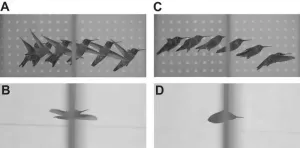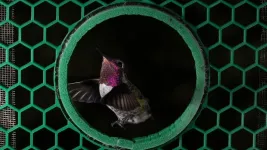(Press-News.org) Researchers from the Texas A&M School of Veterinary Medicine and Biomedical Sciences’ (VMBS) Veterinary Education, Research, and Outreach (VERO) program have joined an international team studying how coronaviruses are spread and whether an individual’s microbiome (the collection of microbes living in or on the body) might impact that transmission.
Coronaviruses are a family of viruses that can cause a variety of diseases in many species, from the common cold and severe acute respiratory syndrome (SARS) in people, to diarrhea in calves and respiratory disease in adult cattle.
The research team — which includes researchers from the United States, the United Kingdom, and Canada — has received $3.5 million from the United States Department of Agriculture National Institute of Food and Agriculture (USDA-NIFA), the National Science Foundation, the National Institutes of Health, and the Biotechnology and Biological Sciences Research Council (BBSRC).
Their work will use cattle as a model for viral transmission during group “commingling events” — when unfamiliar animals or people come together in a defined space and time with intensive and sustained contact.
Commingling is associated with increased disease transmission risk and possible global consequences, as the COVID-19 pandemic has highlighted. Commingling events in humans include large group events, air travel, incarceration, and classroom settings.
Among animals, commingling routinely occurs during livestock production when the body’s ability to fight disease may be lowered, while, at the same time, the body is being exposed to more pathogens.
“It’s more and more the nature of our society that we have these types of commingling events, through travel, socialization, and the general nature of day-to-day interactions,” said Dr. Paul Morley, VERO’s director of food animal research and one of the project’s co-principal investigators. “Being able to understand how viruses behave would help us apply preventive measures, including vaccination and antiviral treatment, for both humans and cattle.”
The researchers, led by Dr. Noelle Noyes, an associate professor in the University of Minnesota College of Veterinary Medicine, will work to understand why some people and animals get infected and/or develop symptoms during commingling events but others do not.
At VERO, Morley and Dr. Matthew Scott, an assistant professor of microbial ecology and infectious disease, will work alongside three graduate students to collect samples from local beef and dairy cattle to track how bovine coronavirus, which is not able to infect people, spreads between animals.
“The Texas Panhandle is one of the greatest epicenters of cattle production in the United States,” Morley said. “We’re taking advantage of our great contacts in the cattle production industries, both beef and dairy, to look at coronavirus transmission in young calves during natural management circumstances.”
Specifically, they will look at how the virus spreads depending on factors like how many cattle are housed together and if they are moved to new locations via livestock trailers. They will also measure the cattle’s immune systems and microbiomes to understand if differences have an impact on whether cattle get infected.
“We’ll be looking at virus shedding before, during, and after commingling events, as well as immune function, genes that get turned on or off, and changes in the microbiomes of the respiratory and gastrointestinal tracts,” Morley said.
Using cattle from real livestock operations will ensure that data collected accurately represents real-world transmission factors.
“We hope to uncover the complex multi-level mechanisms that underlie viral transmission during intensive mixing of unfamiliar calves,” said Dr. Joseph Neary, principal investigator of the project’s U.K. activities. “These new insights will better inform calf husbandry practices to reduce infectious disease transmission risk, particularly where newly mixed calves have been sourced from multiple farms.”
The study will also expand fundamental scientific understanding of viral behavior.
“A unique aspect of this work is the integration of microbiome dynamics into models of virus transmission at the population level,” Noyes said. “There’s a lot of scientific evidence about the importance of the microbiome in individual health, but we don’t have as much understanding of how population-level microbiome dynamics may influence disease transmission, particularly during situations of heightened disease risk, such as commingling.”
The project is expected to last through 2026. In addition to Texas A&M University and the University of Minnesota, collaborators on the project include scientists from Mississippi State University, the University of Liverpool, and the University of Saskatchewan.
“This project is the idealization of what we’re trying to do at VERO, working with people around the world on a big project with big impact,” Morley said. “The impact on our graduate students is going to be tremendous; they’ll get to interact with this internationally renowned, extremely talented group of people. It’s a great opportunity for them in their graduate programs.”
END
Texas A&M researchers contribute to international project studying coronavirus transmission in humans, cattle
Researchers will study viral transmission using “commingling events" with cattle, bringing unfamiliar animals together for sustained contact
2023-11-10
ELSE PRESS RELEASES FROM THIS DATE:
NASA’s Webb, Hubble telescopes combine to create most colorful view of universe
2023-11-10
Astronomers once again have combined the observational powers of NASA’s James Webb Space Telescope and Hubble Space Telescope to create one of the most detailed and colorful portraits of the cosmos, just in time for the holiday season.
The new image, dubbed the Christmas Tree Galaxy Cluster by the research team that includes Texas A&M University astronomer Dr. Lifan Wang, combines visible light from Hubble with infrared light detected by Webb to showcase MACS0416, a galaxy cluster about 4.3 billion light-years from Earth. Because the cluster is able to magnify the light from more distant background galaxies through a phenomenon known as gravitational ...
Ten 2023 postdoctoral fellowships in aging research awarded by the Glenn Foundation for Medical Research and AFAR
2023-11-10
NEW YORK, NY and SANTA BARBARA, CA — The American Federation for Aging Research (AFAR) and the Glenn Foundation for Medical Research are pleased to announce the recipients of the 2023 Glenn Foundation for Medical Research Postdoctoral Fellowships in Aging Research. This program supports postdoctoral fellowswho study basic research mechanisms of aging and/or translational findings that have potential to directly benefit human health.
Selected through a rigorous review process, ten, one-year, $75,000 Postdoctoral ...
Mystery solved: how hummingbirds fly through gaps that are too small
2023-11-10
Soaring, wings outstretched, many birds sail through the air unhindered. However, species that dine on fruit, seeds and nectar must negotiate tiny gaps in cluttered foliage to secure a feast. To pass through apertures, many birds pull in their wings, folding them closer to their bodies. However, some of the most manoeuvrable aviators, hummingbirds, have lost the ability to fold their wings at the wrists and elbows. ‘Unless hummingbirds implement distinctive strategies to transit narrow apertures, they may be unable to enter gaps less than one wingspan wide’, ...
Hummingbirds' unique sideways flutter gets them through small apertures
2023-11-10
Most birds that flit through dense, leafy forests have a strategy for maneuvering through tight windows in the vegetation — they bend their wings at the wrist or elbow and barrel through.
But hummingbirds can't bend their wing bones during flight, so how do they transit the gaps between leaves and tangled branches?
A study published today in the Journal of Experimental Biology shows that hummingbirds have evolved their own unique strategies — two of them, in fact. These strategies have not been reported before, likely because hummers maneuver too ...
National analysis suggests that potentially serious complications occur in 1 in 18 procedures under the care of an anaesthetist
2023-11-10
New survey data from the 7th National Audit Project of the Royal College of Anaesthetists (NAP7) published in Anaesthesia (the journal of the Association of Anaesthetists) shows that potentially serious complications occur in one in 18 procedures under the care of an anaesthetist.
The risk factors associated with these potentially serious complications include very young age (babies); comorbidities; being male; increased frailty; the urgency and extent of surgery; and surgery taking place at night and/or at weekends.
This paper has been produced by a team of authors across ...
Study finds that laser epilation reduces risk of recurrence of pilonidal disease
2023-11-09
Laser epilation, commonly known as laser hair removal, reduced the risk of recurrence in patients with pilonidal disease, an inflammatory, painful, and sometimes chronic or recurring condition, according to research conducted by Peter C. Minneci, M.D., Chair of Surgery at Nemours Children’s Health, Delaware Valley, and published in JAMA Surgery.
Pilonidal disease occurs when cysts form between the buttocks. It is believed to be an inflammatory reaction to hair or debris that gets caught in the crease of the buttocks. The disease occurs in 26 to 100 per 100,000 people and is most common in adolescents and young ...
The U.S. Supreme Court restricted abortion rights and public support for abortion increased
2023-11-09
A new study examining the effects of the U.S. Supreme Court ruling on Dobbs v. Jackson Women's Health Organization on June 24, 2022, which overturned Roe v. Wade's constitutional protection of abortion rights, finds that the American public's support for abortion increased after the decision.
The findings were published today in Nature Behaviour.
"Our results show the extent to which the Supreme Court is out of step with the American public," says co-author Sean Westwood, an associate professor of government at Dartmouth and director of the Polarization Research Lab.
The study's findings were based on a large, three-wave survey before the leak ...
New evidence that heightened pain sensitivity is linked to sympathy for opposing political views
2023-11-09
The next time your friend displays remarkable openness to their opposite political camp’s ideas, you might try pinching them.
Okay, we don’t really recommend that. But new evidence shows that people with increased sensitivity to pain are also more likely to endorse values more common to people of their opposite political persuasion. It doesn’t stop there. They also show stronger support for the other camp’s politicians, and, get this -- more likely to vote for Donald Trump in 2020 if they are liberal, or Joe Biden if they are conservative.
Even ...
C-Path’s pioneering neuroscience workshop transforms the landscape of neurological disorder therapies
2023-11-09
Critical Path Institute (C-Path) is pleased to announce the release of a new peer-reviewed publication, titled “Transforming Drug Development for Neurological Disorders: Proceedings from a Multi-disease Area Workshop,” now published in Neurotherapeutics, The Journal of the American Society for Experimental Neurotherapeutics.
A distinguished team of C-Path scientists and patient-advocates spearheaded by Diane Stephenson, Ph.D., C-Path’s Executive Director of the Critical Path for Parkinson’s Consortium (CPP), has presented its learnings from C-Path’s 2022 Neuroscience Program Annual Workshop. The publication can be accessed in its entirety here.
Neurological ...
How to use AI for discovery — without leading science astray
2023-11-09
Over the past decade, AI has permeated nearly every corner of science: Machine learning models have been used to predict protein structures, estimate the fraction of the Amazon rainforest that has been lost to deforestation and even classify faraway galaxies that might be home to exoplanets.
But while AI can be used to speed scientific discovery — helping researchers make predictions about phenomena that may be difficult or costly to study in the real world — it can also lead scientists astray. In the same way that chatbots sometimes “hallucinate,” ...
LAST 30 PRESS RELEASES:
Fires could emit more air pollution than previously estimated
A new way to map how cells choose their fate
Numbers in our sights affect how we perceive space
SIMJ announces global collaborative book project in commemoration of its 75th anniversary
Air pollution exposure and birth weight
Obstructive sleep apnea risk and mental health conditions among older adults
How talking slows eye movements behind the wheel
The Ceramic Society of Japan’s Oxoate Ceramics Research Association launches new international book project
Heart-brain connection: international study reveals the role of the vagus nerve in keeping the heart young
Researchers identify Rb1 as a predictive biomarker for a new therapeutic strategy in some breast cancers
Survey reveals ethical gaps slowing AI adoption in pediatric surgery
Stimulant ADHD medications work differently than thought
AI overestimates how smart people are, according to HSE economists
HSE researchers create genome-wide map of quadruplexes
Scientists boost cell "powerhouses" to burn more calories
Automatic label checking: The missing step in making reliable medical AI
Low daily alcohol intake linked to 50% heightened mouth cancer risk in India
American Meteorological Society announces Rick Spinrad as 2026 President-Elect
Biomass-based carbon capture spotlighted in newly released global climate webinar recording
Illuminating invisible nano pollutants: advanced bioimaging tracks the full journey of emerging nanoscale contaminants in living systems
How does age affect recovery from spinal cord injury?
Novel AI tool offers prognosis for patients with head and neck cancer
Fathers’ microplastic exposure tied to their children’s metabolic problems
Research validates laboratory model for studying high-grade serous ovarian cancer
SIR 2026 delivers transformative breakthroughs in minimally invasive medicine to improve patient care
Stem Cell Reports most downloaded papers of 2025 highlight the breadth and impact of stem cell research
Oxford-led study estimates NHS spends around 3% of its primary and secondary care budget on the health impacts of heat and cold in England
A researcher’s long quest leads to a smart composite breakthrough
Urban wild bees act as “microbial sensors” of city health.
New study finds where you live affects recovery after a hip fracture
[Press-News.org] Texas A&M researchers contribute to international project studying coronavirus transmission in humans, cattleResearchers will study viral transmission using “commingling events" with cattle, bringing unfamiliar animals together for sustained contact




